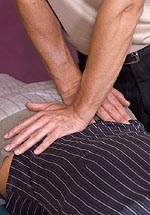Chiropractic Treatment A 2 Z

A chiropractor is a qualified medical professional specializing in disorders, pains and aches that are related to the musculoskeletal system. They most commonly deal with injuries and pains related to the spine, which ultimately affects various segments of the nervous system.
Chiropractic is often seen as an alternative therapy, simply because the treatments are generally drug and surgery free.
There are many reasons for visiting a chiropractor, most commonly when injuries, pain or discomfort occur. However, treatments known as subluxations are apparently beneficial, even if you have no pain or discomfort at all.
A chiropractor is able to diagnose and often treat nerve-related pains and discomfort by performing specialized techniques. The most common technique is manipulation of the spine and vertebrae. As the spine protects the spinal column, which controls all the nerves and sensations throughout the body, oftentimes a slipped, herniated or bulging disk (between the vertebrae) can put pressure on the spinal column, which results in pains and aches on various body parts.
The guide below will give you a brief understanding of the various chiropractic treatments and techniques available:
Subluxation
Chiropractors can set the subluxation of the spine, which basically involves aligning it, to avoid added pressure on the nerves. This kind of treatment can be done even if you have no pain or discomfort and is seen as a good method to ensure optimal spinal alignment.
Specialized Chiropractic Treatments
There are many chiropractic treatments that are used to treat pain, injury and discomfort. Some chiropractors specialize in one treatment; however, most of them use several techniques to treat the condition holistically. The most common treatment method is spinal adjustments and manipulation of the spine.
Chiropractors generally use spinal manipulation and other therapies to try and correct the alignment of the affected nerve with the aim of easing the pain and discomfort. Some of these therapies include:
Author: Dimi Ingle.
Copyright: Remedium. This article may not be copied, in whole or in part, without the written consent of Remedium.
|